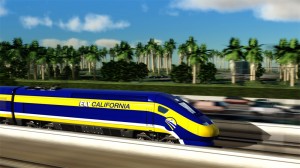 How fast will California’s high speed rail system actually go, once it’s fully built between San Francisco and Downtown Los Angeles? Robert Poole at the libertarian Reason Foundation (and an outspoken opponent of the project) runs the numbers:
How fast will California’s high speed rail system actually go, once it’s fully built between San Francisco and Downtown Los Angeles? Robert Poole at the libertarian Reason Foundation (and an outspoken opponent of the project) runs the numbers:
Each time the business plan gets revised, more of the total 434 miles will operate at speeds well below the 220 mph touted by proponents. Los Angeles Times reporter Ralph Vartabedian in March identified another 30 miles that will run at lower speed: the route between San Jose and San Francisco. Instead of running on an elevated track, the HSR will operate on ground-level tracks through a highly urbanized area with numerous grade crossings. CHSRA claims it can safely operate this stretch at 110 mph—but that is not the case for the privately-funded Brightline train in South Florida. Between Miami and West Palm Beach, its allowed top speed is 70 mph—and that is with extensive safety improvements to grade crossings. Reviewing various CHSRA documents assessed by Vartabedian, I found 91 miles that will likely be restricted to 70 mph and another 45 miles in tunnels where speeds will likely be no higher than 150 mph. Assuming that on the remaining 298 miles the average speed will be 200 mph (due to grades, slowing down for the slower sections, etc.), my estimate of the total elapsed time between Los Angeles and San Francisco is 3.09 hours. And that is a problem, since the ballot measure approved by the voters requires that nonstop journey to take no longer than 2.67 hours.
If Poole is right (and I haven’t reviewed his methodology or assumptions to know), will a 3+ hour ride between San Francisco and LA be a problem for attracting riders? It certainly doesn’t sound as compelling as 2 hours and 40 minutes required by the 2008 ballot initiative. And if you include door-to-door travel time, many riders could be looking at 5 hours between the two cities. That amount of time starts to look equivalent to flying, once you factor in travel to and from the airport, security, and waiting to board and de-plane.
So the only advantage over flying that high speed rail would have at that point would be a slightly cheaper fare, potentially nicer ride (smooth travel over land with great views), and the ability to access interim stops like Fresno or Bakersfield.
Of course, high speed rail has bigger concerns at this point than worrying about long-term travel times. The system’s leaders are struggling just to build the first truly usable section between Fresno and San Jose, and they have no money to get anywhere close to Los Angeles at this point.
But anything that we can do now to speed up the overall travel time will certainly yield ridership benefits down the, er, road.


